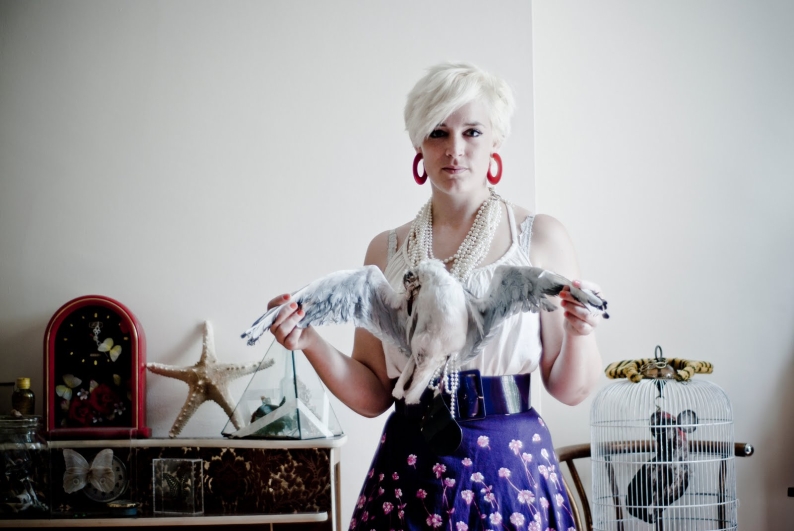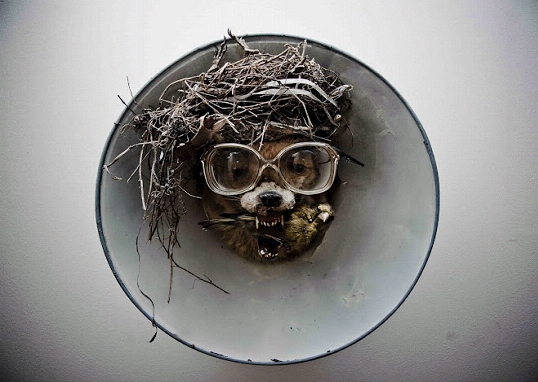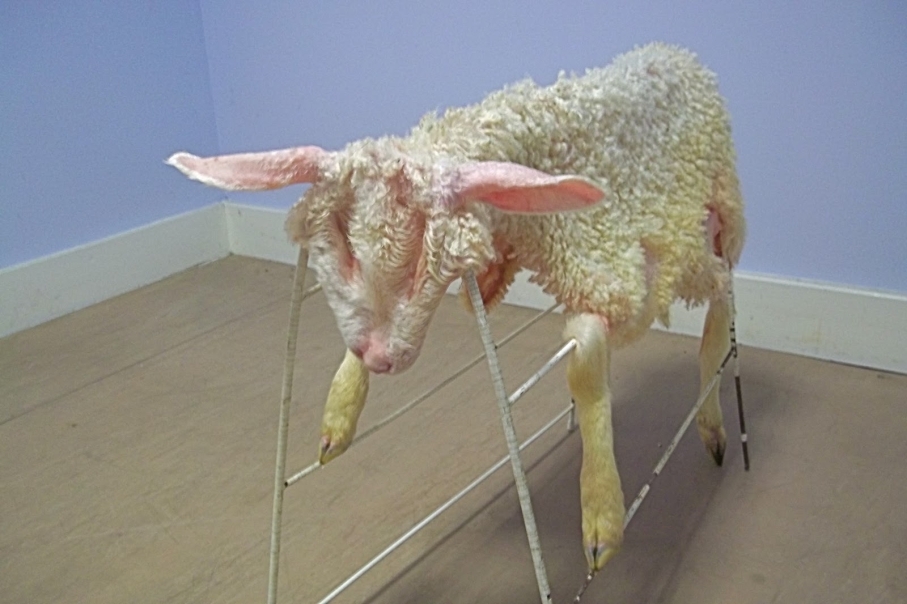The Marshman Chronicles’ Gareth Rees interviews Charlie Tuesday Gates about buried hamsters, boiled crabs and veganism.
What The Dabbler needs, I announced to myself one day, is a rough guide to turning dead animals into art. And with that I jumped on a bus from Clapton to Stamford Hill to talk to artist Charlie Tuesday Gates in her studio.
Charlie is an artist and D.I.Y taxidermist who specialises in darkly humorous sculptures. She eschews the traditional idea that you should make dead animals appear to be alive. Instead she revels in death. Her stuffed fox isn’t a snarling beast poised to attack. He’s wearing goggles, has a bird nest on his head and a bird rammed in his mouth.
Charlie’s view is that anyone can do taxidermy. I decided to find out why and how.
GR: How do you define what you do?
CTG: I’m an artist that uses found materials. It started with waste objects. Then I started incorporating dead things into my work. Then I started seeking out this stuff in abattoirs, gameries…
GR: The stuff they’ll turn into meat anyway?
CTG: There’s a place in Dorset I go to that kill animals for food, but they chuck so much away. I felt so bad seeing all that waste that I turned vegan.
GR: You’re a vegan?
CTG: Yes. Just seeing that hideous waste of life… baby lambs and deers piled high. These beautiful, sacred and magical creatures are just tossed away.
GR: If you think back to traditional cultures, native American Indians for instance, they’d make a point of using every part of an animal they killed. Any bits they couldn’t eat they’d use as decoration. Taxidermy is not just some new Hoxton fad. It was integral to culture.
CTG: Absolutely. I have all sorts of things rotting in the back because I can’t bear to get rid…
GR: Where do you get the animals from, is it only abattoirs?
CTG: You’d be surprised. I constantly get text messages from people saying things like “I’ve just seen a dead fox on the way to Croydon”. I carry around plastic bags all the time. Even if the animal has been got at I’ll scrape it off the road.
GR: Traditional taxidermists need whole animals, right?
CTG: Yes, they need something undamaged that hasn’t been left to rot, but I’m not fussed.
GR: Do you have a set of personal guidelines for finding your
animals?
CTG: I’m definitely ethical about it, but didn’t know about these ethics until I got started. When I first began I ordered these domestic rabbits. It was heartbreaking. They were old stock that had been sent back from pet shops. These are kept in huge overcrowded warehouses. The rabbits are just kicked around. The bodies I got had been bitten all over, bones broken. It was horrible. I can’t justify sourcing things like that. I only use waste, things that I find.
GR: You said that anybody can do taxidermy. How do they source if they’re going to be ethical?
CTG: They can go to a gamery where things are being shot for food. The butchers as well.
GR: What would you ask for?
CTG: Ask where they get their wild rabbits from, and ask them to pass on their details. Or just take a jaunt into the countryside, see what you can find.
GR: Let’s say you’re a beginner and you’ve got your dead animal. How much mess is involved?
CTG: Surprisingly little, because the blood stops flowing. And it depends on whether you know about anatomy or not… I picked it up pretty quickly. In terms of smell, it depends on how long it’s been around. You have to get rid of the insides quickly, or turn them into something…
GR: Like a hat?
CTG [Laughs] Yes, like a hat.
GR: Is there a disease risk?
CTG: It’s not something I worry about. Obviously you have to wear gloves, and buy a good flea spray.
GR: What’s the law on road kill?
CTG: Obviously some things are illegal, you can’t touch things that are endangered or game birds out of season. If you did want to do this you’d have to get special licences, you can get it all the info from the taxidermist guild (www.taxidermy.org.uk). Always keep a record of the animal, where you found it and when. If you find a nice specimen you can send in pictures and they’ll make a decision.
GR: What do you need?
CTG: A number 22 curved surgical scalpel blade. Some gloves. Salt. Cotton wool. Any old cloth material to stuff it with. A leather needle and thread. And perhaps a nice dry room. If you want to make the animal look like a living animal you’ll need a mould which you can buy.
GR: So you take the animal, clean it, rub with salt – a bit like curing a ham I suppose?
CTG: Yes, this takes out the moisture, then it pretty much lasts forever. I then stuff it with things like sanitary towels, gives it a bizarre twist.
GR: Not good if you drop the stuffed animal in water and it expands.
CTG: Exactly.
GR: What were your influences?
CTG: I grew up I Dorset. Animals were everywhere. I was the sort of person who saw something dead and wanted to poke it. I used to hide bodies in secret places. Once I accidentally buried my gerbils alive because I thought they were dead. That gave me nightmares for a while.
I have memories of scraping my cat off the road. We thought it was a dead fox on the way to and from school. I always had a morbid curiosity. I had a baby chick that died, I went and dug that up a few months later…just to see what it was like… mind you, I was 22. My friends remember coming to the kitchen and seeing me pulling eyeballs off a chicken and I’d say “Would you like a yoghurt?”
GR: Is it harder for you now in London?
CTG: The only animal-related making stuff I’ve done is in London, since I became an artist.
GR: And your childhood experiences came rushing back to you.
CTG: Yes, that’s it.
GR: What was your first piece?
CTG: I was boiling crabs at the beginning university, just to use in sculptures. I‘d see them in Peckham in bags and think “You poor things, you’re dying, you’d look lovely in a piece of sculpture – I’ll save you!”
GR: Were you doing an art degree?
CTG: I studied sculpture but only started doing this after I left university. Suddenly I had a studio, I worked on my own, and nobody saw my. One thing led to another and suddenly I was a real artist.
GR: So what’s the future for taxidermy?
Taxidermy as a traditional thing – they’ve been doing it many hundreds of years and it’s getting mainstream again. But other versions of it are becoming more extreme and artistic.
GR: There’s quite a fashion for it at the moment.
CTG: It’s quite annoying. It was a good thing when interest started picking up, but now it’s everywhere and when something is everywhere it becomes meaningless. It means there are certain things I don’t do, or I step away from, or I just get more and more extreme.















Its amazing what artists will do to source their materials. A friend of mine recently spent the entire day soaking hundreds of owl pellets in the bath before seperating them by hand to remove the mouse bones. Whatever floats your boat!
As far as Im aware this recent taxidermy craze seems to date back to around the time of Damien Hirst’s attempted purchase of Walter Potter’s tableaux from Jamaica Inn
Personally I have always wanted a stuffed dog but don’t think the missus will ever allow it in the house
Well, if you can surmount that small problem, I can introduce you to a place in Paris… (http://www.design-nature-paris.fr/) Everything, and it really does look like everything is available. I have a crow. Fancy a magpie.
Worm, the Walter Potter sale was in 2003. I think the current trend dates back to Hirst’s ‘iconic’ 1992 work, The Physcial Impossibility of Death in the Mind of Someone Living (aka shark in formaldehyde).
During the early part of my long union with Mrs Mahler (let’s call her Alma), she willingly accepted an unmerciful ragging from the rest of the family because she was (and remains) the only smoker. She countered, that when ‘she was gone’ we could have her ‘stuffed, and sit me on the mantle with a fag in my mouth’.
Your piece about Charlie has set me thinking that, instead of treating this like a long-standing family joke, I could start thinking about making some plans to actually do it. Charlie makes it sound quite simple, and I have had some experience eviscerating rabbits and pigeon. How hard could it be, on a slightly bigger scale? I trip to Stamford Hill, I think….
very interesting – puts me in mind of some stuff by Steve Dilworth, as for example here http://www.stevedilworth.com/page5.htm where the cat dessicated itself, so to speak, with arsenic from rats it had caught. There’s also Mr Crow, who is shut inside some bogwood – see here http://twitpic.com/6nppyc – and others. All suitably shamanic.
I recall coming across gamekeepers gibbets when I were a lad. Fascinatingly gruesome.
My friends live in the Scottish highlands. One time I went up, Mel returned with a young deer in the boot of the car. Dead. Ran out in front of her. Jason decided this was the time to show the lily liverered Londoner (me) some proper country life. He lured the local gilly over with promises of whisky. One we were inebriated we took the deer to the burn and put it on its back. By this time it was dark. The gilly took out a hooked blade and started disembowling the deer by torchlight. A hot stench hit my nostrils. It was disgusting. My job was to hold one of the legs. The gilly kept pulling out organs and sloshing them into the burn. Eventually he was done and we returned to the fireside and left the skin hanging upside down outside. The next morning it was frozen. Icicles of blood dripped from its head. We spent three more days getting drunk, occasionally staring out at the accidental frozen sculpture feeling guilty about the waste.